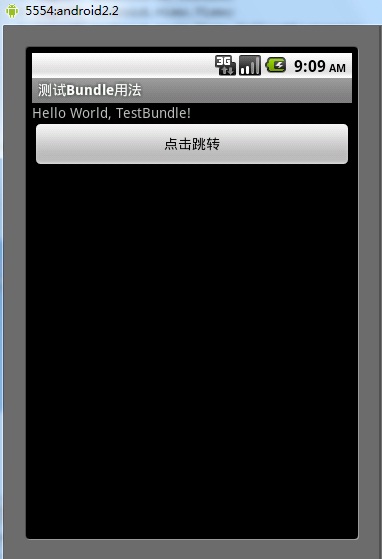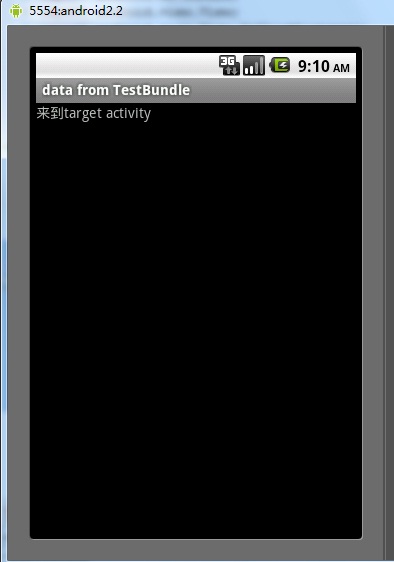今天发现自己连Bundle类都没有搞清楚,于是花时间研究了一下。
根据google官方的文档(http://developer.android.com/reference/android/os/Bundle.html)
Bundle类是一个key-value对,“A mapping from String values to various Parcelable types.”
类继承关系:
java.lang.Object
android.os.Bundle
Bundle类是一个final类:
public final class
Bundle
extends Objectimplements Parcelable Cloneable
两个activity之间的通讯可以通过bundle类来实现,做法就是:
(1)新建一个bundle类
- Bundle mBundle = new Bundle();
Bundle mBundle = new Bundle();
(2)bundle类中加入数据(key -value的形式,另一个activity里面取数据的时候,就要用到key,找出对应的value)
- mBundle.putString("Data", "data from TestBundle");
mBundle.putString("Data", "data from TestBundle");
(3)新建一个intent对象,并将该bundle加入这个intent对象
- Intent intent = new Intent();
- intent.setClass(TestBundle.this, Target.class);
- intent.putExtras(mBundle);
Intent intent = new Intent(); intent.setClass(TestBundle.this, Target.class); intent.putExtras(mBundle);
完整代码如下:
android mainfest.xml如下:
- <?xml version="1.0" encoding="utf-8"?>
- <manifest xmlns:android="http://schemas.android.com/apk/res/android"
- package="com.tencent.test"
- android:versionCode="1"
- android:versionName="1.0">
- <application android:icon="@drawable/icon" android:label="@string/app_name">
- <activity android:name=".TestBundle"
- android:label="@string/app_name">
- <intent-filter>
- <action android:name="android.intent.action.MAIN" />
- <category android:name="android.intent.category.LAUNCHER" />
- </intent-filter>
- </activity>
- <activity android:name=".Target"></activity>
- </application>
- <uses-sdk android:minSdkVersion="7" />
- </manifest>
<?xml version="1.0" encoding="utf-8"?>
<manifest xmlns:android="http://schemas.android.com/apk/res/android"
package="com.tencent.test"
android:versionCode="1"
android:versionName="1.0">
<application android:icon="@drawable/icon" android:label="@string/app_name">
<activity android:name=".TestBundle"
android:label="@string/app_name">
<intent-filter>
<action android:name="android.intent.action.MAIN" />
<category android:name="android.intent.category.LAUNCHER" />
</intent-filter>
</activity>
<activity android:name=".Target"></activity>
</application>
<uses-sdk android:minSdkVersion="7" />
</manifest>
两个类如下:intent从TestBundle类发起,到Target类。
类1:TestBundle类:
- import android.app.Activity;
- import android.content.Intent;
- import android.os.Bundle;
- import android.view.View;
- import android.view.View.OnClickListener;
- import android.widget.Button;
- public class TestBundle extends Activity {
- private Button button1;
- private OnClickListener cl;
- public void onCreate(Bundle savedInstanceState) {
- super.onCreate(savedInstanceState);
- setContentView(R.layout.main);
- button1 = (Button) findViewById(R.id.button1);
- cl = new OnClickListener(){
- @Override
- public void onClick(View arg0) {
- // TODO Auto-generated method stub
- Intent intent = new Intent();
- intent.setClass(TestBundle.this, Target.class);
- Bundle mBundle = new Bundle();
- mBundle.putString("Data", "data from TestBundle");//压入数据
- intent.putExtras(mBundle);
- startActivity(intent);
- }
- };
- button1.setOnClickListener(cl);
- }
- }
import android.app.Activity;
import android.content.Intent;
import android.os.Bundle;
import android.view.View;
import android.view.View.OnClickListener;
import android.widget.Button;
public class TestBundle extends Activity {
private Button button1;
private OnClickListener cl;
public void onCreate(Bundle savedInstanceState) {
super.onCreate(savedInstanceState);
setContentView(R.layout.main);
button1 = (Button) findViewById(R.id.button1);
cl = new OnClickListener(){
@Override
public void onClick(View arg0) {
// TODO Auto-generated method stub
Intent intent = new Intent();
intent.setClass(TestBundle.this, Target.class);
Bundle mBundle = new Bundle();
mBundle.putString("Data", "data from TestBundle");//压入数据
intent.putExtras(mBundle);
startActivity(intent);
}
};
button1.setOnClickListener(cl);
}
}
类2: Target
- import android.app.Activity;
- import android.os.Bundle;
- public class Target extends Activity{
- public void onCreate(Bundle savedInstanceState) {
- super.onCreate(savedInstanceState);
- setContentView(R.layout.target);
- <span style="color:#ff6600;">Bundle bundle = getIntent().getExtras(); </span> //得到传过来的bundle
- String data = bundle.getString("Data");//读出数据
- setTitle(data);
- }
- }
import android.app.Activity;
import android.os.Bundle;
public class Target extends Activity{
public void onCreate(Bundle savedInstanceState) {
super.onCreate(savedInstanceState);
setContentView(R.layout.target);
Bundle bundle = getIntent().getExtras(); //得到传过来的bundle
String data = bundle.getString("Data");//读出数据
setTitle(data);
}
}
布局文件:
main.xml
- <?xml version="1.0" encoding="utf-8"?>
- <LinearLayout xmlns:android="http://schemas.android.com/apk/res/android"
- android:orientation="vertical"
- android:layout_width="fill_parent"
- android:layout_height="fill_parent"
- >
- <TextView
- android:layout_width="fill_parent"
- android:layout_height="wrap_content"
- android:text="@string/hello"
- />
- <Button
- android:layout_width="fill_parent"
- android:layout_height="wrap_content"
- android:text="@string/button"
- android:id = "@+id/button1"
- />
- </LinearLayout>
<?xml version="1.0" encoding="utf-8"?>
<LinearLayout xmlns:android="http://schemas.android.com/apk/res/android"
android:orientation="vertical"
android:layout_width="fill_parent"
android:layout_height="fill_parent"
>
<TextView
android:layout_width="fill_parent"
android:layout_height="wrap_content"
android:text="@string/hello"
/>
<Button
android:layout_width="fill_parent"
android:layout_height="wrap_content"
android:text="@string/button"
android:id = "@+id/button1"
/>
</LinearLayout>
target.xml
- <?xml version="1.0" encoding="utf-8"?>
- <LinearLayout xmlns:android="http://schemas.android.com/apk/res/android"
- android:orientation="vertical"
- android:layout_width="fill_parent"
- android:layout_height="fill_parent"
- >
- <TextView
- android:layout_width="fill_parent"
- android:layout_height="wrap_content"
- android:text="@string/target"
- />
- </LinearLayout>
<?xml version="1.0" encoding="utf-8"?>
<LinearLayout xmlns:android="http://schemas.android.com/apk/res/android"
android:orientation="vertical"
android:layout_width="fill_parent"
android:layout_height="fill_parent"
>
<TextView
android:layout_width="fill_parent"
android:layout_height="wrap_content"
android:text="@string/target"
/>
</LinearLayout>
String.xml
- <?xml version="1.0" encoding="utf-8"?>
- <resources>
- <string name="hello">Hello World, TestBundle!</string>
- <string name="app_name">测试Bundle用法</string>
- <string name="button">点击跳转</string>
- <string name="target">来到target activity</string>
- </resources>
<?xml version="1.0" encoding="utf-8"?>
<resources>
<string name="hello">Hello World, TestBundle!</string>
<string name="app_name">测试Bundle用法</string>
<string name="button">点击跳转</string>
<string name="target">来到target activity</string>
</resources>
结果:

跳转结果:
